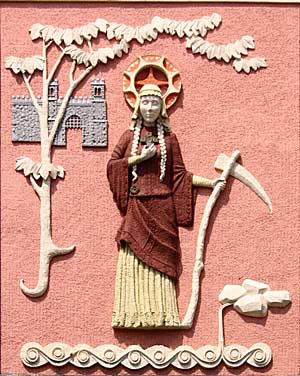
St Sidwell's Mural
Page updated 3 March 2021
This large, colourful sculpture/mural which can be found on the front of the old Tesco store, next to St Sidwells Church, depicts St Sidwella.
It is not known when she existed, or not, but it was after the Romans left, and the Britons of the south west were mostly pagans, and a few early Christians. It is said that Sidwella (or Sativola), the daughter of a wealthy British Romanized family lived in a small area outside what is now known as St Sidwells. Bernna, her father, a Christian, died, leaving his young children in the care of a pagan stepmother. Sidwell had two sisters, Urith of Chittlehampton and Juthera of Dorset, who are both said to have suffered the same fate as Sidwella.
Her father left her the bulk of his fortune, consisting of land east of the city wall. Her stepmother, you've guessed it, bitter and jealous of her fortune, so she plotted Sidwella's death. As Sidwella knelt in silent prayer in a cornfield, at Hedewell Mede, a corn reaper, paid by her stepmother, crept up and cut off her head with a scythe. A spring of pure water appeared from the ground, where her head came to rest. Her body was buried on the site of St Sidwells Church, making her Exeter's very own saint, and a martyr. Soon, pilgrims visited her shrine, and the well water is said to have cured the sick.
The wall art was commissioned by Tesco, in 1969, and created by Frederick Irving, an art teacher Bideford Art College. The face of St Sidwell was based on Meg Compton who was a student at the college. She had to lay back on a bench while her face was sculpted from clay. Compton was also asked to plat the hair for the piece, out of clay. A plaster mould was made from the clay to allow the piece to be fabricated from fibre glass.
There is a stained glass window in the Cathedral, one in Ashton Church and All Saints College, Oxford. Some Devon churches also have her depicted on their rood screens. Her feast day varies between 31 July, and the 1 and 2 August. The 1 August is the day that Lammas Fair has been held for the last 900 years, although whether there is a connection is not known.

│ Top of Page │